雅思阅读快速定位三步走
雅思阅读中的关键词定位方法
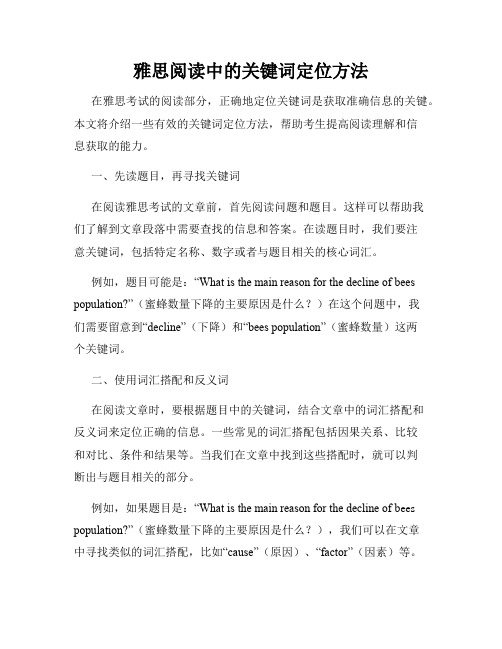
雅思阅读中的关键词定位方法在雅思考试的阅读部分,正确地定位关键词是获取准确信息的关键。
本文将介绍一些有效的关键词定位方法,帮助考生提高阅读理解和信息获取的能力。
一、先读题目,再寻找关键词在阅读雅思考试的文章前,首先阅读问题和题目。
这样可以帮助我们了解到文章段落中需要查找的信息和答案。
在读题目时,我们要注意关键词,包括特定名称、数字或者与题目相关的核心词汇。
例如,题目可能是:“What is the main reason for the decline of bees population?”(蜜蜂数量下降的主要原因是什么?)在这个问题中,我们需要留意到“decline”(下降)和“bees population”(蜜蜂数量)这两个关键词。
二、使用词汇搭配和反义词在阅读文章时,要根据题目中的关键词,结合文章中的词汇搭配和反义词来定位正确的信息。
一些常见的词汇搭配包括因果关系、比较和对比、条件和结果等。
当我们在文章中找到这些搭配时,就可以判断出与题目相关的部分。
例如,如果题目是:“What is the main reason for the decline of b ees population?”(蜜蜂数量下降的主要原因是什么?),我们可以在文章中寻找类似的词汇搭配,比如“cause”(原因)、“factor”(因素)等。
同时,还要留意反义词,比如“increase”(增加)等,以排除不相关的内容。
三、注意同义词和近义词在阅读雅思文章时,往往会遇到同义词或者近义词的替换。
因此,要特别注意文章中的词汇选择和替换词。
当我们在题目中看到某个词汇时,需要在文章中寻找其同义词或者近义词,以定位正确的信息。
例如,题目可能是:“What is the main reason for the decline of bees population?”(蜜蜂数量下降的主要原因是什么?),文章中可能用到“reduce”(减少)、“diminish”(减少)等近义词。
雅思阅读备考技巧如何快速找到文章中的观点和论证
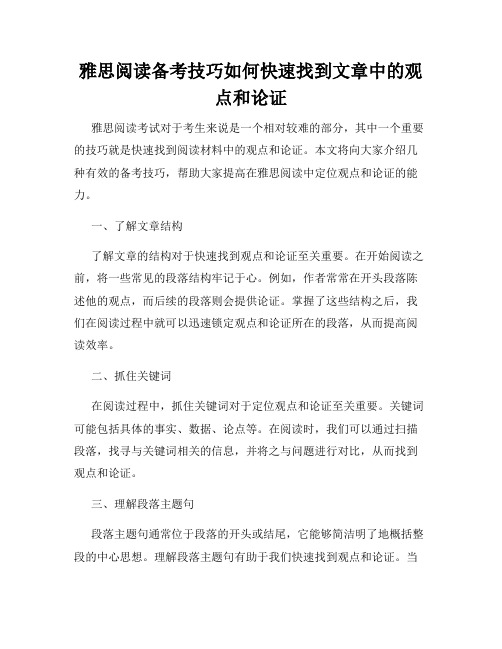
雅思阅读备考技巧如何快速找到文章中的观点和论证雅思阅读考试对于考生来说是一个相对较难的部分,其中一个重要的技巧就是快速找到阅读材料中的观点和论证。
本文将向大家介绍几种有效的备考技巧,帮助大家提高在雅思阅读中定位观点和论证的能力。
一、了解文章结构了解文章的结构对于快速找到观点和论证至关重要。
在开始阅读之前,将一些常见的段落结构牢记于心。
例如,作者常常在开头段落陈述他的观点,而后续的段落则会提供论证。
掌握了这些结构之后,我们在阅读过程中就可以迅速锁定观点和论证所在的段落,从而提高阅读效率。
二、抓住关键词在阅读过程中,抓住关键词对于定位观点和论证至关重要。
关键词可能包括具体的事实、数据、论点等。
在阅读时,我们可以通过扫描段落,找寻与关键词相关的信息,并将之与问题进行对比,从而找到观点和论证。
三、理解段落主题句段落主题句通常位于段落的开头或结尾,它能够简洁明了地概括整段的中心思想。
理解段落主题句有助于我们快速找到观点和论证。
当我们读到主题句时,可以将其与问题进行对比,找出与问题相关的观点和论证。
四、注意连接词和指示词连接词和指示词在文章中起到连接和引导作用。
例如,"因为"、"所以"、"但是"等连接词往往标志着作者的观点或论证的转折点。
而"这种"、"这样"、"那"等指示词则指向了问题的答案所在。
通过留意这些词语,我们能够更快地找到观点和论证。
五、善用排除法在阅读考试中,有时我们需要根据问题信息来排除选项。
在找到相关段落后,我们可以逐个排除与问题无关的选项,从而更快地找到正确答案。
善用排除法可以帮助我们快速剔除干扰项,集中精力于观点和论证的定位。
六、多练习,多积累最后,要快速找到文章中的观点和论证,需要大量的练习和积累。
多读一些雅思阅读材料,阅读不同题型的文章,积累不同类型的观点和论证句式。
雅思阅读定位法

雅思阅读定位法寻找3种语言重现同其他考试的阅读部分相比,雅思考试阅读部分最大的特点是文章篇幅长。
考生要在一个小时内完成8种类型共计40道题目(这个要求近乎苛刻)。
因此,阅读目的就从单纯的“信息获取’’转变成”寻找答案”。
在这个过程中,原文涉及的大部分细节内容对于完成题目是无意义的,无需字斟句酌。
只有在阅读中准确把握题干的关键词,才能区分哪些字句与题目(答题点)有关。
所谓“关键词’’是指题干中的核心词或者决定答案性质或位置的词。
典型的关键词是句子的主干、人名、地名、时间、数字和生词。
由于它们会在原文重现,因此产生了一种答题方法:回原文找关键词。
这往往给考生一种印象:只要在题干中划出关键词就一定能找到原词。
那么关键词一定会“原型”重现吗?请看下面这道判断题:Example: While it is acknowledged for many years that an increasing number of animals are bound to become extinct,it is only recently that the problem has been addressed by politicians.题目: We have known for along time that more species of animals will disappear.(判断题)1. AA语言重现关键词在原文中以原词形式出现。
AA语言重现在试题中占的比例最大,也是最简单的一类考法。
它以特殊关键词为主,包括人名、地名、时间、数字和生词。
Example:原文:At precisely 4:20 am on Friday the 24th of September 1993 it was announced that Sydney had beaten five other competing cities around the world,and Australians everywhere,not only Sydney-siders,were justifiably proud of the result.But,if Sydney had lost the bid,would the taxpayers of NESW and of Australia have approved of government's spending millions of dollars in a failed and costly exercise?题目:How many cities were competing in 1993 for the right to hold the 2000 Games? (简答题)2.AB语言重现定义:关键词A在原文中以同义词B的形式出现。
雅思阅读的关键在如何定位

雅思阅读的关键在如何定位很多同学在雅思阅读中都遇到过这样的情况:在原文中找了半天,看了好几段内容,也没有看出原文哪句话可以判断出题目的答案,今天给大家带来了雅思阅读的关键在如何定位,希望能够帮助到大家,下面就和大家分享,来欣赏一下吧雅思阅读的关键在如何定位!如何来迅速的在一篇长达1000多词的*中定到位呢?一、从原文中找“特殊词”什么样的词是“特殊词”呢?特殊词,顾名思义就是样子特殊、很容易在原文中找到的词。
比如:时间,地点,人名,书名,杂志名,专有名词,斜体字,引号引出的词,A-B类型的词。
这些词要么是数字(阿拉伯数字或是用英语单词表述的数字,需要注意形式),要么是首字母大写的词,在原文中很容易被快速找到。
二、从题干中找“定位词”然而,不是所有的题目中都包含这样的“特殊词”的,在雅思阅读中更多的题目是不包含“特殊词”的题目,这无疑增加了定位的难度。
但是如果我们能通过读题迅速判断出决定题目所在的这句话不同于文中其他句子的相对独特的词,再在原文中找到这些相对独特的词我们就可以准确的找到原文的位置了。
我们来看几个例子,横线划出的是定位词:Endangered languages cannot be saved unless people learn to speak more than one language.Saving languages from extinction is not in itself a satisfactory goal.The way we think may be determined by our language.Young people often reject the established way of life in their community.A change of language may mean a loss of traditional culture.三、通过题目的前后顺序帮助定位我们都知道五种小题型、判断题、选择题、总结题的顺序性都是极强的,那么在定位的时候我们可以通过前后的题目来帮助定位,就进一步加快了我们定位的速度。
《雅思阅读定位法》课件

本课程将为大家介绍什么是雅思阅读定位法,以及为什么定位法是解决雅思 阅读难题的最佳方法。
定位法简介
1 什么是雅思阅读定位法?
雅思阅读定位法是通过一定的技巧和方法,找到一篇文章中与题目相关的信息,快速找 到正确答案的方法。
2 为什么需要使用定位法?
在时间紧张的考场环境下,使用阅读定位法可以帮助考生快速定位到正确答步骤一:快速浏览题目和段落
标题
步骤二:扫读与题目相关的关 键词
2
通过快速浏览标题和题目,了解文章 的结构和主题,找到与题目相关的段
落。
通过扫读文章,找到与题目相关的关
键词,帮助快速定位答案。
3
步骤三:寻找与题目相关的句
子
通过细读文章,找到与关键词相关的
步骤四:确认答案选项
4
句子,判断答案是否正确。
通过回顾题目和文章的相关内容,确 认答案选项是否完全正确。
定位法实例分析
实例一:匹配题
通过快速浏览和扫读文章,找 到与选项有关的关键词,并在 文中查找匹配信息,避免被诱 导选错答案。
实例二:填空题
通过将选项填入文章中,找到 文中空缺的关键词,或通过前 后文推断,确定填空答案。
实例三:判断题
通过关键词和段落主题判断选 项的正误,注意词形和词义的 转化。
定位法技巧与注意事项
技巧一:选择正确的关键词
通过判断选项类型和阅读文章获取关键词,不要过于依赖题目中出现的关键词。
技巧二:掌握表达转换技巧
注意同义词、词性和形态的表达转换,避免选错答案。
总结
1 通过阅读本课程,相信大家已经了解了什么是雅思阅读定位法,以及如何使用该技巧快速定位
答案。希望大家可以在考试中灵活运用阅读定位法,帮助提高雅思阅读成绩。
雅思阅读定位技巧实践方法

雅思阅读定位技巧实践方法
雅思阅读是考试中难度较大的部分之一,想要取得好成绩需要提高自己的定位技巧。
下面是一些实践方法来帮助你提高雅思阅读的定位能力:
1. 阅读前的素材准备:在开始阅读练习之前,可以通过阅读英语书籍、报纸、杂志,以及在网上搜索相关的文章来提高自己的英语阅读能力。
2. 练习快速阅读:雅思阅读的时间是有限的,所以需要提高自己的阅读速度。
练习快速阅读,并试着用你的眼睛迅速浏览文章的大意。
3. 练习首尾句定位:每段文章的首尾句通常包含了该段的主要信息。
练习通过快速阅读找出每段文章的首尾句,可以帮助你更快地定位到相关信息。
4. 练习划重点:在阅读过程中,通过划重点的方式来标记出重要的信息。
可以使用不同的颜色来标记不同类型的信息,这样可以在回答问题时更方便地找到所需的信息。
5. 练习标记关键词:阅读时要注意标记关键词。
关键词通常是文章中出现频率较高的词语,可以帮助你更容易地找到相关信息。
6. 练习推测选项:在解答题目时,可以根据文章中的线索和推测来选择答案。
练习通过理解文章的意思和选择正确的答案可以帮助你提高阅读的定位能力。
7. 多做模拟题:通过多做雅思阅读的模拟题来提高自己的定位能力。
模拟题是和真实考试很接近的练习,可以帮助你熟悉考试的形式和内容,并提高自己的应试能力。
最重要的是,不断地练习是提高雅思阅读定位技巧最有效的方法。
通过长时间的练习和积累,你的定位能力会逐渐得到提高。
雅思阅读定位技巧的3个实施步骤讲解

雅思阅读定位技巧的3个实施步骤讲解雅思阅读定位技巧的3个实施步骤讲解定位词选取总原则在雅思阅读的定位中,我们主要是通过定位词来确定题目对应的文章具体部分,其原因在于简短精确,节省时间,毕竟雅思阅读文章篇幅很长,阅读量大,一个小时的时间对于大多数烤鸭们来讲实在不算充裕.那么如何选取定位词?首先,选取定位词需要遵循一个总的原则,即——以名词为主.在此提醒烤鸭们不要忘记了雅思阅读考试的核心是同义替换,从考试核心出发,名词在各类词性中意思相对且明确,也因此不容易出现替换,所以在选取定位词的过程中,首先需要寻找的便是名词.当然这并不表示所有的名词都可以用作定位词.我们首先选取名词作为定位词的原因是其意思相对明确,不易替换,但是名词中有一类是不符合这个特点的——抽象名词.抽象名词可以举出很多例子, 诸如reason,idea,definition… 我们以definition 为例,definition的意思是〝定义,解释〞,一篇文章中可能会出现对多个专家学者对某一特定现象的解释或阐释,那么在这篇文章中,每一个学者说过的话,都是一个〝definition〞,如此一来,如果我们选择某一题目中的〝definition〞作为定位词,那么该题目便无法对应到文章中的具体部分,显然就无法进一步解答了.因此,在定位词的选取上,我们要遵循名词为主的总原则,但是要排除掉名词中的抽象名词一类.寻找特殊词在以名词为主的总原则下,我们要进一步睁大我们的眼睛,去发现题目中的〝特殊词〞.那么何为〝特殊词〞?常见的〝特殊词〞又有哪些?(1)以大写.斜体形式出现的词雅思阅读中会有字体上的差异,大多数情况下,如果我们在题目中读到了以大写或是斜体形式出现的单词,这些词因其〝外形〞上的与众不同,值得我们格外留意,一般来讲,这类词是适合选择的定位词.(2)数字众所周知,英文里的数字相对来讲拼写繁琐,所以大多数情况下,阅读中出现的数字都是以阿拉伯数字形式出现的,包括百分数.分数等等,也因此数字在大多数情况下在一堆英文字母里就显得格外突出啦!所以,一般来讲,数字同样也是适合选作定位的〝特殊词〞之一.(3)时间雅思阅读中涉及到的时间非常多,大到世纪,小到分秒.时间同样是一类适合选择作为定位词的〝特殊词〞.时间的特性之一便是其性,而这恰恰符合我们选择定位词的要求,诸如_85.二十世纪等都是且确定的时间,同样容易发现,且不易替换.更不用说年份这类词尝尝是以阿拉伯数字形式出现的,就更加显眼了!(4)人名学术类阅读中常常涉及各类专家.学者,因此人名同样是出镜频率较高的一类〝特殊词〞.人名出现需要大写,且拼写方式明显与其他词不同,烤鸭们最头疼的替换问题更是完全不需要担心!因此,一般情况下,人名同样是题目中适合作为定位词的〝特殊词〞.〝特殊词〞的特殊情况首先看题目中有无〝特殊词〞的原因是其显眼好找,且不易替换的特性.〝不易替换〞当然不等于〝不会替换〞,考官们在〝特殊词〞上,也会想尽办法,企图难倒众烤鸭们.例如数字上容易出现特殊情况的百分数.《剑桥雅思 7》Test 2 Passage 3 的第 34题 :〝The survey concluded that one-fifth or 20% of the household transportrequirement as outside the local area.〞中选择〝20%〞作为定位词,而回到文章中却根本没有发现 20%这个数字,实际上就是考官耍了一个小trick,20% outside 在文章中变成了 80% within.所以,当用百分数 _ 作为定位词没有找到对应时,我们要去寻找 1-_.没有〝特殊词〞怎么办要始终坚信,考官是冷酷无情的!他们是不会轻易放过烤鸭们的,所以大多数情况下,只有少部分题目中会出现上述容易定位的〝特殊词〞.在没有〝特殊词〞的情况下,我们需要选择普通词作为主要定位词.首先,普通词定位同样是建立在词性原则基础上的,即以名词为主.其次,我们在选取普通定位词的时候,重点是关注一道题目中的主语名词和宾语名词.一般情况下,我们以主语名词为主,宾语名词为辅.原因在于主语名词中的〝主〞字,其重要性已经不言而喻,所以一道没有〝特殊词〞的题目,我们首先应当关注主语名词.但是,当宾语名词与主语名词相比,宾语名词是一个更加不熟悉.不常见,甚至完全不认识的词时,宾语名词就一跃成为了主要定位词.原因有两点:(1)该词在文章中的对应性很强,有可能仅在此文中出现并进行专门讨论.(2)该词本身就是一个专有名词,那么该词就从一个所谓的〝普通词〞变成了不易,甚至是无法替换的〝特殊词〞.例如, 剑 7 Test 1 Passage 2 中第 _ 题:〝Feeding increasing populations is possible due primarily to improved irrigation systems.〞中的〝irrigationsystems〞,即灌溉系统一词,大多数烤鸭初看该词并不知道其准确意思,但是它属于要以宾语名词为主的情况,且本身就是一个专有名词,文中该词也是以原词形式出现的.同样的情况也适用于第 26 题:〝In the future, governments should maintain ownership of waterinfrastructures.〞的〝infrastructures〞一词.所以,当没有〝特殊词〞,而只能选用普通词定位时,我们需要将题目中的主语名词和宾语名词选出并比较,一般情况下以主语名词为主,宾语名词为辅;当宾语名词更加不熟悉.不常见,甚至完全不认识时,以宾语名词为主要定位词.同时需要提出的是,普通词定位大概率会出现同义替换,要想做到精确定位,除了掌握好定位原则之外,还需要在同义词上多下功夫!总结定位原则的掌握,离不开训练量的支撑,需要我们多做真题,在练习的过程中记忆并掌握定位原则,同时积累特殊情况.需要牢记的是,定位原则一定要灵活使用,在遵循总原则的前提下,根据题目进行具体变通,当使用单个定位词无法做到精确定位时,可以选择多个定位词;在名词无法使用时,同样可以去用动词作为定位词,切莫在一个词上纠结过久消耗大量时间,导致其他题目没有时间去做,这无疑是捡了芝麻,丢了西瓜.雅思阅读复习材料雅思阅读辅导之使用杀虫剂的明显弊端One glaring disadvantage of pesticides application is that, while destroyingharmful pests, they also wipe out many useful non-targeted organisms, which keepthe growth of the pest population in check. This results in what agroecologistscall the treadmill syndrome . Because of their tremendous breeding potentialand genetic diversity, many pests are known to withstand synthetic chemicals andbear offspring with a built-in resistance to pesticides.段落大意本段介绍了使用杀虫剂的明显弊端:杀死了抑制害虫的生物;害虫抵抗化学制品.阅读笔记Disadvantage of pesticides application:Wipe out useful non-targeted organisms(control growth of pest)→ treadmillsyndromeTremendous breeding potential + genetic diversity→withstand syntheticchemicals bear offspring with built-in resistance逻辑关系1. 因果(逻辑连接词: BECAUSE OF)Their tremendous breeding potential and genetic diversity.Many pests are known to withstand synthetic chemicals and bear offspring witha built-in resistance to pesticides.雅思阅读复习材料阅读段落It was not until the eighteenth century that Europe became seriouslyinterested in the possibilities of using the rocket itself as a weapon of warand not just to propel other weapons. Prior to this, rockets were used only inpyrotechnic displays. The incentive for the more aggressive use of rockets camenot from within the European continent but from far-away India, whose leadershad built up a corps of racketeers and used rockets successfully against theBritish in the late eighteenth century. The Indian rockets used against theBritish were described by a British Captain serving in India as ‘an ironenvelope about 200 millimeters long and 40 millimeters in diameter with sharppoints at the top and a 3m-long bamboo guiding stick’. In the early nineteenthcentury the British began to e_periment with incendiary barrage rockets. TheBritish rocket differed from the Indian version in that it was completelyencased in a stout, iron cylinder, terminating in a conical head, measuring onemeter in diameter and having a stick almost five meters long and constructed insuch a way that it could be firmly attached to the body of the rocket. TheAmericans developed a rocket, complete with its own launcher, to use against theMe_icans in the mid-nineteenth century. A long cylindrical tube was propped upby two sticks and fastened to the top of the launcher, thereby allowing therockets to be inserted and lit from the other end. However, the results weresometimes not that impressive as the behavior of the rockets in flight was lessthan predictable.段落大意本段介绍了欧洲火箭弹的发明受印度影响,并介绍了印.英.美三国最早的火箭弹.阅读笔记Europe :1 Until the _th century, interested in using the rocket itself as a weaponof war.( incentive came from India)2 Prior to this were used only in pyrotechnic displays.Indian rockets:1. Used against the British in the late _th century.2. An iron envelope; length: 200 mm, diameter: 400 mm; sharp points at thetop, a 3m-long bamboo guiding stick.British incendiary barrage rockets:1 In the early _th century.2 Encased in a stout, iron cylinder, terminating in a conical head; Diameter: 1m, a stick almost 5m-long.Americans rocket:1. Against the Me_icans in the mid-_th century.2. Own launcher.3. A long cylindrical tube was propped up by two sticks and fastened to thetop of the launcher.雅思阅读长难句翻译练习之定语从句篇雅思阅读要想上高分,一定要学会正确翻译文章中的长难句.今天小编给大家带来了雅思阅雅思阅读表格填空题讲解:WhatDoWhalesFeel 如果你的剑桥雅思阅读已是烂熟于心,那么这一系列的雅思阅读机经真题真的很适合你,今雅思阅读错题原因量化分析雅思阅读错题原因量化分析 ,提分从读懂错误开始.小编给大家带来了雅思阅读错题原因量雅思阅读选词摘要题的出题特点.解题步骤讲雅思阅读选词摘要题型是怎样的呢?下面小编给大家带来了雅思阅读选词摘要题的出题特点。
雅思阅读的阅读顺序
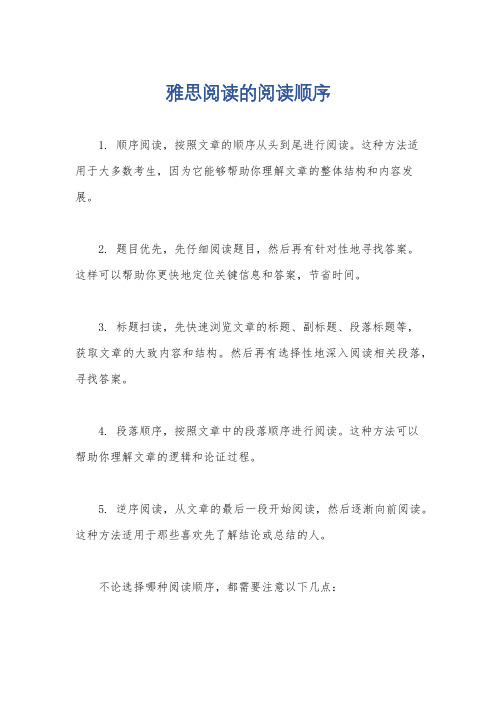
雅思阅读的阅读顺序
1. 顺序阅读,按照文章的顺序从头到尾进行阅读。
这种方法适
用于大多数考生,因为它能够帮助你理解文章的整体结构和内容发展。
2. 题目优先,先仔细阅读题目,然后再有针对性地寻找答案。
这样可以帮助你更快地定位关键信息和答案,节省时间。
3. 标题扫读,先快速浏览文章的标题、副标题、段落标题等,
获取文章的大致内容和结构。
然后再有选择性地深入阅读相关段落,寻找答案。
4. 段落顺序,按照文章中的段落顺序进行阅读。
这种方法可以
帮助你理解文章的逻辑和论证过程。
5. 逆序阅读,从文章的最后一段开始阅读,然后逐渐向前阅读。
这种方法适用于那些喜欢先了解结论或总结的人。
不论选择哪种阅读顺序,都需要注意以下几点:
仔细阅读题目和问题要求,确保理解清楚要求。
注意文章的关键词和关键信息,帮助定位答案。
注意文章的结构和段落之间的逻辑关系,帮助理解文章的主旨
和论证过程。
注意文章的态度和观点,帮助理解作者的意图和观点。
总之,选择适合自己的阅读顺序,并结合题目要求和个人策略,有针对性地进行阅读,可以提高阅读效率和准确性。
雅思阅读定位技巧
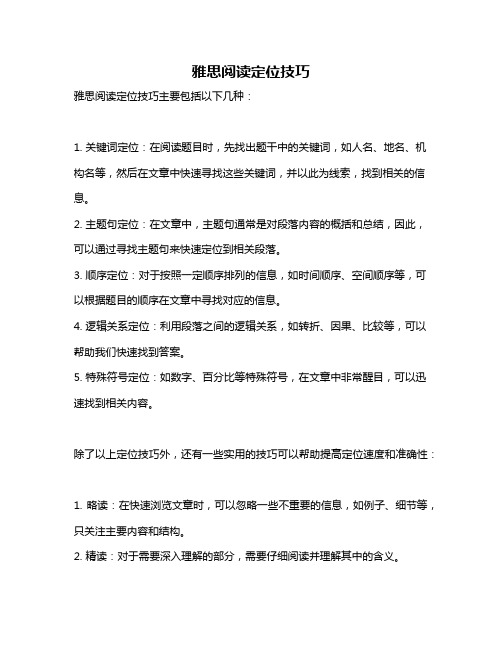
雅思阅读定位技巧
雅思阅读定位技巧主要包括以下几种:
1. 关键词定位:在阅读题目时,先找出题干中的关键词,如人名、地名、机构名等,然后在文章中快速寻找这些关键词,并以此为线索,找到相关的信息。
2. 主题句定位:在文章中,主题句通常是对段落内容的概括和总结,因此,可以通过寻找主题句来快速定位到相关段落。
3. 顺序定位:对于按照一定顺序排列的信息,如时间顺序、空间顺序等,可以根据题目的顺序在文章中寻找对应的信息。
4. 逻辑关系定位:利用段落之间的逻辑关系,如转折、因果、比较等,可以帮助我们快速找到答案。
5. 特殊符号定位:如数字、百分比等特殊符号,在文章中非常醒目,可以迅速找到相关内容。
除了以上定位技巧外,还有一些实用的技巧可以帮助提高定位速度和准确性:
1. 略读:在快速浏览文章时,可以忽略一些不重要的信息,如例子、细节等,只关注主要内容和结构。
2. 精读:对于需要深入理解的部分,需要仔细阅读并理解其中的含义。
3. 划重点:在阅读过程中,可以将重要的信息、关键词或主题句划线或标记,方便后续查找。
4. 预测答案:根据题目和定位的信息,可以预测可能的答案并注意相关内容。
5. 检查答案:在完成题目后,应仔细检查答案是否符合题目的要求和定位的信息。
总之,定位技巧在雅思阅读中非常重要,需要不断练习和积累经验。
通过掌握这些技巧,可以提高阅读速度和准确性,为取得好成绩打下基础。
如何在雅思阅读考试中快速找到关键细节

如何在雅思阅读考试中快速找到关键细节在雅思阅读考试中,找到关键细节是提高阅读理解能力的重要一环。
准确快速地找到关键细节可以帮助考生更好地答题,并且节约宝贵的时间。
本文将介绍一些有效的方法和技巧,让考生在雅思阅读考试中能够迅速找到关键细节并取得更好的成绩。
一、构建正确的阅读框架在开始阅读之前,建立一个正确的阅读框架是很重要的。
考生应该了解文章的结构和主题,并对可能涉及的主题有一定的背景知识。
阅读题目前,先扫一遍文章,了解文章的大致内容和段落组织。
这样可以帮助考生在阅读时更有针对性地寻找关键细节。
二、注意关键词在阅读过程中,关键词起着非常重要的作用。
关键词通常会出现在题目和答案中,帮助考生定位和找到相关的细节。
考生应该注重寻找与题目有关的关键词,例如特定的名词、数字或者时间点。
同时,注意词形变化和近义词的使用也是很重要的。
在找到关键词后,考生可以继续阅读相关部分,寻找答案所在的句子或段落。
三、利用定位词定位词是帮助考生快速找到关键细节的好助手。
常见的定位词包括表示地点、时间、数量、顺序等的词语。
通过定位词,考生可以更精准地定位到文章中与题目相关的部分。
例如,定位词"however"可以帮助考生找到转折的关键细节。
四、注意词语的修饰和转折在阅读中,修饰词语常常会提供关键细节的线索。
考生应该注意词语的修饰形式,例如形容词和副词的使用。
这些修饰词语可以帮助考生更准确地理解文章,并定位到关键细节。
此外,转折词语也常常与关键细节相关。
转折词语会引导文章中的转折点,并在转折处提供关键信息。
考生应该留意这些转折词语,以找到相关的关键细节。
五、训练速读技巧雅思阅读考试中,时间是非常宝贵的。
为了更好地找到关键细节,并答题更快速,考生可以进行速读训练。
速读技巧包括从文章中抓住主题句、粗略阅读段落的开头和结尾,以及学会快速浏览内容。
这些技巧可以帮助考生在较短时间内捕捉到关键细节,提高答题效率。
总结:在雅思阅读考试中,快速找到关键细节是提高阅读理解能力的关键。
雅思阅读定位技巧的3个实施步骤讲解

雅思阅读定位技巧的3个实施步骤讲解雅思阅读定位技巧的3个实施步骤讲解(附例题分析)用具体的例题给大家讲解了雅思阅读中的定位这个技巧。
这个技巧在雅思阅读中运用广泛,是一个强烈建议掌握的技巧。
下面就和大家分享,来欣赏一下吧。
雅思阅读定位技巧的3个实施步骤讲解定位词选取总原则在雅思阅读的定位中,我们主要是通过定位词来确定题目对应的*具体部分,其原因在于简短精确,节省时间,毕竟雅思阅读*篇幅很长,阅读量大,一个小时的时间对于大多数烤鸭们来讲实在不算充裕。
那么如何选取定位词?首先,选取定位词需要遵循一个总的原则,即——以名词为主。
在此提醒烤鸭们不要忘记了雅思阅读考试的核心是同义替换,从考试核心出发,名词在各类词性中意思相对且明确,也因此不容易出现替换,所以在选取定位词的过程中,首先需要寻找的便是名词。
当然这并不表示所有的名词都可以用作定位词。
我们首先选取名词作为定位词的原因是其意思相对明确,不易替换,但是名词中有一类是不符合这个特点的——抽象名词。
抽象名词可以举出很多例子,诸如reason,idea,definition… 我们以definition 为例,definition 的意思是“定义,解释”,一篇*中可能会出现对多个专家学者对某一特定现象的解释或阐释,那么在这篇*中,每一个学者说过的话,都是一个“definition”,如此一来,如果我们选择某一题目中的“definition”作为定位词,那么该题目便无法对应到*中的具体部分,显然就无法进一步解答了。
因此,在定位词的选取上,我们要遵循名词为主的总原则,但是要排除掉名词中的抽象名词一类。
寻找特殊词在以名词为主的总原则下,我们要进一步睁大我们的眼睛,去发现题目中的“特殊词”。
那么何为“特殊词”?常见的“特殊词”又有哪些?(1)以大写、斜体形式出现的词雅思阅读中会有字体上的差异,大多数情况下,如果我们在题目中读到了以大写或是斜体形式出现的单词,这些词因其“外形”上的与众不同,值得我们格外留意,一般来讲,这类词是适合选择的定位词。
雅思阅读如何快速找到

雅思阅读如何快速找到雅思阅读如何快速找到答案雅思阅读部分是考生中最棘手的一部分,尤其是在有限的时间内找到正确答案更加具有挑战性。
以下将介绍一些技巧和策略,帮助考生快速找到答案。
1. 预览题目在开始阅读之前,花几分钟时间预览题目。
阅读题目的目的是了解文章的主题和问题类型,这样在具体阅读过程中会更有针对性。
注意关键词和问题的要求,以便能在文章中快速找到相关信息。
2. 扫读文章在正式阅读之前,快速扫读全文,注意段落开头和结尾的句子,了解文章的整体结构。
这有助于理解文章主旨和句子之间的关联。
同时,在扫读过程中留意标题、图表、图像和粗体字等突出信息。
这些部分通常包含着答案的线索。
3. 学会定位定位是快速找到答案的关键技巧。
根据题目的要求,在文章中标记出关键词或关键句,以便能在需要的时候很快找到它们。
可以使用划线、圈出或做标记的方式来定位。
训练自己在阅读过程中快速而准确地找到所需信息,提高定位的速度和准确性。
4. 注意同义词和同义表达在雅思阅读中,有时文章中的词语与题目中所用的词语不完全一样。
因此,要提高快速找到答案的能力,需要注意同义词和同义表达。
当发现文章中某个词语与题目中的词语意思相同或相近时,就可以推断出这个词语与题目答案间的联系。
5. 利用关键字搜索有时,题目中会给出关键字,考生可以利用这些关键字在文章中搜索答案。
将题目中的关键词和文章中的段落或句子进行匹配,帮助快速定位出正确答案。
这是一种有效的方法来寻找有关问题的信息。
6. 注意转折词和逻辑关系词在阅读过程中,特别留意转折词和逻辑关系词,如however、therefore、because等。
这些词语在文章中起到连接句子和表明逻辑关系的作用,对于理解文章的意思和找到答案非常重要。
7. 练习阅读技巧除了学习上述策略外,考生还需要通过大量的练习来提高阅读能力。
通过练习,可以熟悉不同题型的要求和文章的结构特点。
逐渐培养对文章的整体理解能力和定位答案的技巧,从而在考试中更快速地找到正确答案。
雅思阅读定位技巧的基本做法和实践方法

雅思阅读定位技巧的基本做法和实践方法雅思阅读定位技巧的基本做法和实践方法讲解了在雅思阅读中可以说是用途最广且最有必要的一个技巧——定位的思路和方法。
下面我就和大家共享,来观赏一下吧。
雅思阅读定位技巧的基本做法和实践方法众所周知,雅思索试与其他英文考试不同。
其不同之处不仅仅在于听说读写全面考察的考试模式,多种多样的试题类型,更在于出题者的出题思路和考察目的跟广阔烤鸭们早已习惯的中式英文考试截然不同。
正是这些不同,导致了许多中国烤鸭屡屡败走麦城。
由于在接受了多年的有中国特色的英文教育和考试后,我们大多习惯了“无孔不入”型试题。
出题者们绞尽脑汁,竭尽全力挖掘各个犄角旮旯的小细节,不“烤糊”一片誓不罢休;考生们乐观捧场,本着“宁可错杀一千,不能放过一个”的指导方针,决不放过任何细节。
(这种状况在阅读部分尤其突出)在这种考试思想的指导下,中国同学都有一种通病,就是及其注意所看到细节,越是看上去没什么大用的信息,越感爱好。
用这种阅读习惯来做雅思阅读,是中国烤鸭的致命伤。
雅思阅读定位技巧的基本思路大家都知道,雅思阅读基本技巧就是抓住关键词回文章去定位。
基本程序就是:1. 在题干中挑出关键词2. 考虑文中可能消失的同义词或者近义词(paraphrase)3. 快速回文章找到相关段落,精读key word四周的一句或几句话4. 依据文意做题目以中国同学中学所接受的高强度的语法及词汇教育来说,step2的paraphrase过程实在是a piece of cake。
关键在于key word。
究竟什么词才是key word。
许多习惯考高校英语四六级的人,会发觉自己总是不自觉的就把目光投向一些小词,如形容词或频率副词上面。
建议大家在着手预备雅思阅读的时候,先练习一下如何审题。
由于分析题干是做雅思阅读特别重要的第一步。
带着问题,有的放矢的去看文章才是最经济实惠的方法。
用铅笔划出关键词。
关键词绝大多数应当是实义的名词,数词,专出名词,学术名词等不太简单被替换的词汇。
雅思阅读怎么找到定位词

雅思阅读怎么找到定位词
在雅思阅读中,定位词是指能够帮助我们快速定位文章中对应段落或信息的关键词。
1.选择题干中的关键词:在选择题干中的关键词时,可以选择一些具有代表性的词汇,例如名词、动词、形容词等。
这些关键词可以帮助我们快速定位到文章中对应的信息。
2.使用特殊标记:可以将题干中的关键词用特殊的标记标记出来,例如用下划线或斜杠标记出来。
这样可以帮助我们在阅读文章时快速识别出对应的信息。
3.利用语法和逻辑关系:在选择定位词时,可以利用语法和逻辑关系来帮助我们判断关键词。
例如,在名词前面通常有形容词或动词修饰,可以通过这些修饰词来确定关键词。
4.注意同义词和反义词:在选择定位词时,可以注意同义词和反义词。
例如,在题干中找到的关键词可能在文章中以同义词或反义词的形式出现,需要留意对应的信息。
5.利用题目顺序:在选择定位词时,可以利用题目顺序来帮助我们判断关键词。
一般来说,雅思阅读的题目顺序是按照文章段落顺序排列的,因此可以根据题目的顺序来判断关键词的位置。
在找到定位词后,可以通过在文章中搜索对应的信息来确定答案。
需要注意的是,在搜索时需要留意题干中的关键词和文章中的对应信息是否一致,以确保找到的答案是准确的。
雅思阅读备考如何快速找到段落大意
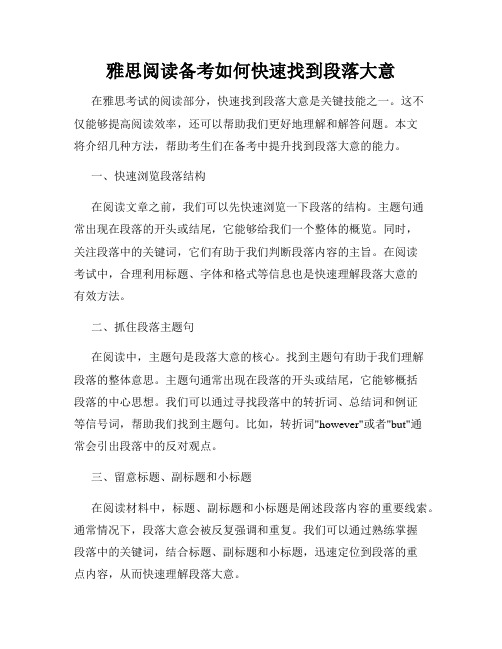
雅思阅读备考如何快速找到段落大意在雅思考试的阅读部分,快速找到段落大意是关键技能之一。
这不仅能够提高阅读效率,还可以帮助我们更好地理解和解答问题。
本文将介绍几种方法,帮助考生们在备考中提升找到段落大意的能力。
一、快速浏览段落结构在阅读文章之前,我们可以先快速浏览一下段落的结构。
主题句通常出现在段落的开头或结尾,它能够给我们一个整体的概览。
同时,关注段落中的关键词,它们有助于我们判断段落内容的主旨。
在阅读考试中,合理利用标题、字体和格式等信息也是快速理解段落大意的有效方法。
二、抓住段落主题句在阅读中,主题句是段落大意的核心。
找到主题句有助于我们理解段落的整体意思。
主题句通常出现在段落的开头或结尾,它能够概括段落的中心思想。
我们可以通过寻找段落中的转折词、总结词和例证等信号词,帮助我们找到主题句。
比如,转折词"however"或者"but"通常会引出段落中的反对观点。
三、留意标题、副标题和小标题在阅读材料中,标题、副标题和小标题是阐述段落内容的重要线索。
通常情况下,段落大意会被反复强调和重复。
我们可以通过熟练掌握段落中的关键词,结合标题、副标题和小标题,迅速定位到段落的重点内容,从而快速理解段落大意。
四、关注段落的第一句和最后一句段落的第一句通常是段落大意的引子,它能够帮助我们快速抓住段落的主旨。
而段落的最后一句通常是段落大意的总结,它能够为我们加深对段落内容的理解。
因此,在阅读时,我们应该特别留意段落的第一句和最后一句,它们有助于我们快速捕捉到段落的中心思想。
五、练习阅读速度和理解能力除了以上方法,多做一些练习也是提高快速找到段落大意能力的重要途径。
可以通过做题来锻炼自己的阅读速度和理解能力。
在练习时,不仅要追求速度,更要注重提升理解,只有两者兼顾,才能够在备考中真正做到快速找到段落大意。
六、总结复习笔记最后,我们还可以通过总结复习笔记的方式,巩固对段落大意的把握。
雅思阅读定位

雅思阅读定位
雅思阅读定位是指在阅读理解题中,根据题目要求准确地找到相关信息的过程。
以下是一些建议来帮助你进行雅思阅读定位:
1. 预览题目:在阅读文章之前,先预览题目和选项,了解大致的内容和问题类型。
这样可以帮助你更有针对性地搜索相关信息。
2. 关键词标记:在阅读文章时,将题目中的关键词标记出来,以便快速定位相关段落或句子。
这些关键词通常与题目中的问题或选项相对应。
3. 找准段落:注意文章的结构,尤其是段落的开头和结尾。
往往会在这些位置找到答案的线索。
此外,一些信号词如“首先”、“然而”、“因此”等也能帮助你追踪文章的逻辑。
4. 上下文推断:如果你在某个段落中找不到答案,可以试着往前后的段落寻找相关信息。
有时候,答案可能需要通过上下文的推断才能确定。
5. 可能性排除法:如果你找到了一个看似正确的答案,但还有其他选项,可以使用排除法来选择最合适的答案。
通过仔细阅读选项并与文章进行比较,排除那些不符合要求的选项。
希望这些建议能帮助你在雅思阅读中更好地进行定位。
记住,练习是提高定位能力的关键,多做一些模拟题和真实的雅思阅读材料会有很大帮助。
- 1、下载文档前请自行甄别文档内容的完整性,平台不提供额外的编辑、内容补充、找答案等附加服务。
- 2、"仅部分预览"的文档,不可在线预览部分如存在完整性等问题,可反馈申请退款(可完整预览的文档不适用该条件!)。
- 3、如文档侵犯您的权益,请联系客服反馈,我们会尽快为您处理(人工客服工作时间:9:00-18:30)。
雅思阅读快速定位三步走朗阁雅思考试研究中心众多的烤鸭们都知道,在我们雅思阅读考试中,不仅要求考生要有上千上万的词汇量,首先,词汇量是基础,其次我们做题时还是需要有速度的哦。
有的考生觉得自己已经在平时练习的过程中达到了高速的要求了,但是还是会在考试中来不及做,这是为什么呢,其实这个是可以分两个方面来进行分析,首要的问题还是烤鸭们还没有达到的快速阅读的标准,比如说我们要在1小时内,高效率的完成40个问题,不仅要快,同时还要求正确率,如此说来就得需要考生们对问题答案所在位置的快速精准定位;另一方面的原因应该就是烤鸭们在考试过程中的一些紧张情绪导致没有在考试过程中很好的发挥,或者就是虽然提升了速度但是在选择答案的时候还是因为对自己答案的不自信,导致最后还是没有办法高效快速的完成题目!本文中,朗阁雅思考试研究中心的专家将以剑桥雅思4中的几篇文章为例,给考生们讲解快速定位法。
段落定位要求考生在拿到一篇文章后,首先要对文章进行略读,读文章标题,每个段落的首尾句,掌握文章的大意,了解每段在讲什么,有助于下一步看问题的时候可以先确定这个问题的段落位置。
词汇定位要求考生在对文章略读后,看问题,并划出定位词。
定位词在之前《雅思阅读之定位》一文中已经讨论过,主要是一些名词。
结合对每段意思的掌握,确定好问题的段落位置后,再通过划出的问题中的定位词在段落中定位答案的最后位置。
要是就那样分析的话,可能很多烤鸭会觉得比较抽象,没有办法具体的了解到,那么下面我们就来用举例说明的方式来具体说一下,希望对烤鸭们有所帮助哟!1. 略读题目和段落Title: What do whales feel?An examination of the functioning of the senses in cetaceans, the group of mammals comprising whales, dolphins and porpoises.从对标题的阅读中,我们可以了解到这篇文章要讲的是鲸的感官,the senses of whales. 在这里我们可以预测下感官有哪些,同时可以对下面文章的内容进行预测。
Paragraph1:Some of the senses that we and other terrestrial mammals take for granted areeither reduced or absent in cetaceans for fail to function well in water. For example, it appears from their brain structure that toothed species are unable to smell. Baleen species, on the other hand, appear to have some related brain structures but it is not known whether these are functional. It has been speculated that, as the blowholes evolved and migrated to the top of the head, the neural pathways serving sense of smell may have been nearly all sacrificed. Similarly, although at least some cetaceans have taste buds, the nerves serving these have degenerated or are rudimentary.从首句的主干中得出一些感官在退化,消失或者在水中已失去了功用。
紧跟在这句话后面的是个for example, 说明后面再举些这类型的感官。
最后一句以similarly开头,说明即使最后一句也是一个例子,然后是个名词taste buds, 说到了味觉,用了degenerated, rudimentary描述这个味觉,rudimentary大多数考生不认识,但degenerated可以根据构词法推出是退化。
Paragraph2:The sense of vision is developed to different degrees in different species. Baleen species studied at close quarters underwater-specifically a grey whale calf in captivity for a year, and free-ranging right whales and humpback whales studied and filmed off Argentina and Hawaii-have obviously tracked objects with vision underwater, and they can apparently see moderately well both in water and in air. However, the position of the eyes so restricts and field of vision in baleen whales that they probably do not have stereoscopic vision.读首句就可看出这段讲的是视觉。
最后一句提到了baleen whales的眼睛位置限制了它们的视觉域,they probably do not have stereoscopic vision.Paragraph3:On the other hand, the position of the eyes in most dolphins and porpoises suggests that they have stereoscopic vision forward and downward. Eye position in freshwater dolphins, which often swim on their side or upside down while feeding, suggests that what vision they have is stereoscopic forward and upward. By comparison, the bottlenose dolphin has extremely keen vision in water. Judging from the way it watches and tracks airborne flying fish, it can apparently see fairly well through the air-water interface as well. And although preliminary experimental evidence suggests that their in-air vision is poor, the accuracy with which dolphins leap high to take small fish out of a trainer’s hand provides anecdotal evidence to the contrary.首句有on the other hand表转折,说明要和上段有联系,接着往后看又说到了眼睛的位置,这次说的是most dolphins and porpoises, they are not like the baleen whales, they have stereoscopic vision forward and downward.Paragraph4:Such variation can no doubt be explained with reference to the habitats in which individual species have developed. For example, vision is obviously more useful to species inhabiting clear open waters than to those living in turbid rivers and flooded plains. The South American boutu and Chinese beiji, for instance, appear to have very limited vision, and the Indian susus are blind, their eyes reduced to slits that probably allow them to sense only the direction and intensity of light.首句一读的话会发现一个重要的词汇habitats. 在这句之后又有了for example, 同时看到了vision, 说明这段讲vision和habitats的关系。
2. 问题中划关键词对文章的大意和每个段落的大意了解后,接着看问题,Questions15-21.这是个表格,首先看到字数限制:不超过三个单词。
然后看这个表格,有四列,分别是:sense, species, ability and comments.看到sense, 分为了smell, taste, touch, vision and hearing, 正好对应了文章的几个段落。
Question15对应taste, 是文章的第一段,然后通过划出问题中的定位名词nerves 去第一段定位,找到最后一句,对其进行分析后发现问题中的underdeveloped和文章中的degenerated是同义的,因此这里填taste buds.Question16-19对应vision, 文中第三,四,五段讲解vision。
然后Question16是species,预测是动物,划出定位词stereoscopic vision. Question17划出定位词dolphins, porpoises, stereoscopic vision, Question18同样预测是填入动物类型的词,定位词stereoscopic vision forward and upward. Question19划出定位词bottlenose dolphin, air-water interface, 去文章中的这三段定位,找答案。
